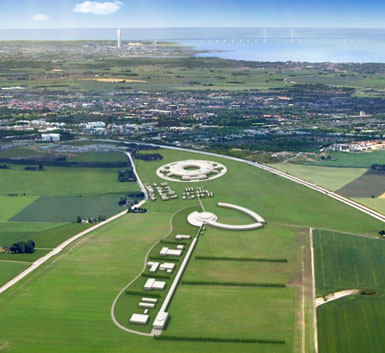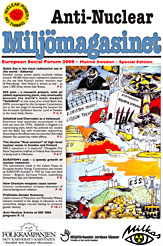Spallation
ESS – the first investment (20 billion SEK) towards an accelerator driven system for transmutation of nuclear waste?
European Spallation Source (ESS) in Lund, Sweden, is planned to be the worlds biggest proton accelerator which bombards a target with high energy protons to release neutrons. In an accelerator driven system for transmutation of nuclear waste – you need a “neutron cannon” like ESS. The information about that You will not find on ESS home page where the plan is marketed as a research project for common good:
The next, second and third, following steps would be – completion of the nuclear waste transmutation plant by the establishment of 2) a burner reactor and 3) a reprocessing plant, like Sellafield – which spreads radioactivity hundred folds more than usual nuclear reactors. The facilities are then covered by powerfull sarcofague cielings.
ESS – Not in our backwater!
Our ocean – the Baltic Sea – is allready the most radioactive body of water in the whole world (according to the best international experts, from the Helsinki Commission’s regional group of scientist, HELCOM MORS).
A nuclear waste transmutation plant is exactly the very last thing we want to have by an ocean, which we allready know is in the worst possible marine radioactive crisis.
Anti-Nuclear Magasine´s main subject is ESS
Download it by clicking on the image on Your right side here. You may translate the texts into Your native language and we will gladly provide You with the layout of this magasine to print it.
Here is the timetable:
2009: The countries supporting Lund must submit suggestions on how they will contribute to financing.
It is already clear that Sweden will take 30 percent of the budget, Denmark 12.5 per cent while the other Nordic and Baltic countries are loading up to 50 percent.
European Investment Bank is ready with a loan equal to 15 percent of the funding and other countries will then take 35 percent – either in the form of cash or “in kind” in the form of materials and technology.
2009-2010: Application for construction will be printed and submitted to the County Board for consideration under the Environmental Code, the Radiation Protection Authority and the municipality for approval under the Planning and Building Act.
2009-2011: Final design of the facility with technical drawings and the decisions about exactly what the ESS facility will be able to do and how to do it.
Some scientists and engineers from other plants and universtitet, including CERN, will be involved. Even now, two accelerator specialists recruited from Cern – Englishman Steve Pegg and Swede Mats Lindros.
Uppsala University, which has several leading neutronforskare, expects to receive a major role in the design and construction.
2012: Shovel into the ground and begin construction. The building envelope, the conventional part of the plant, expected to go in 4-5 billion – one third of total investment.
2012-2018/19: Builds up and running. The assignments are expected to go directly to the Swedish builders and contractors since the ESS is an international organization not subject to EU procurement laws.
2015-2019: Neutron canon built and ESS-equip the plant for its specific purpose.
2019 switched power to the gun and the first neutrons into production in seven of the 23 planned experiment stations.
2019-2023: Remaining 16 experimental stations are built. The annual operating cost of the ESS facility is estimated at 900 million crowns.

